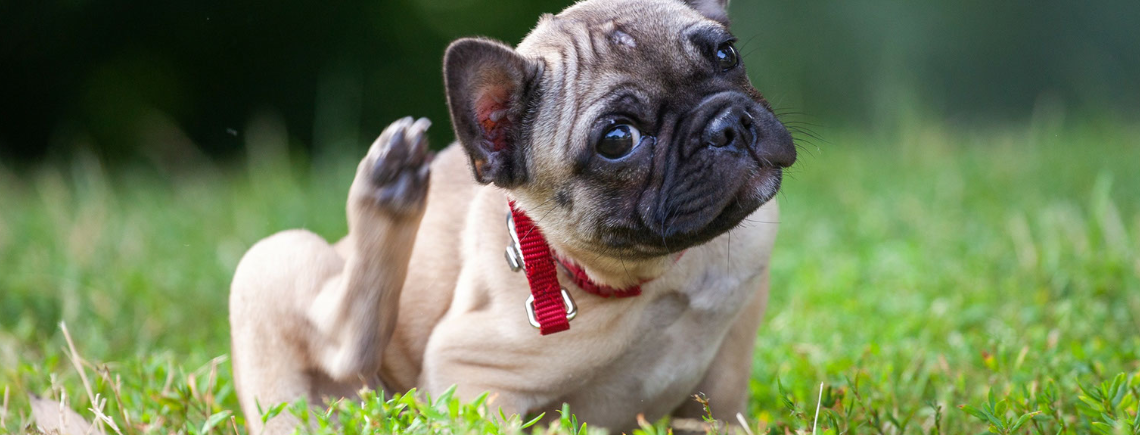Treating Hot Spots on Your Dog
Canine hot spots are a common health condition in dogs. They are red, inflamed skin lesions that appear quickly, ooze, and may contain pus. They can be found anywhere on a dog’s body, but the most common problem areas are the head, legs, and hips. These sores can be painful, smelly and itchy, and may be very obvious or hidden beneath matted fur. They can spread rapidly and be frustrating to deal with; however, they can be treated and even prevented with the right management.

Tara Murphy, Professional Groomer
Tara started working in Petmania in 2008 and has had many achievements along the way. She completed her City and Guilds Professional Dog Grooming exams and achieved a Diploma. Not too long after, she entered a IPDGA competition where she placed 4th in the Open Clipped Class. She is also a qualified Canine First Responder Instructor and delivers this class to groomers within Petmania. After working as a groomer for 7 years, she started the Petmania Grooming Academy in Petmania Kilkenny in 2015. Today she is an integral part of the Petmania Grooming Team.
What Are The Causes of Hot Spots?
Hot spots are usually the result of when a dog scratches an itchy spot so vigorously that he creates an open wound. This trauma to the skin causes inflammation and even secondary bacterial infections.
Dogs scratch for many reasons but regardless of the cause, hot spots can be a nuisance. When a dog licks the sore spot, he irritates his nerve endings in the skin which arouses more itching, licking, biting, and scratching. This lick-itch-lick cycle is the basis for the self-trauma that causes hot spots. Over a short period of time, hot spots can increase dramatically in size; dog owners may go to work after noticing a pin-point area of redness and come home at the end of the day to find it has grown in size.
Certain breeds such as Golden Retrievers, English Bulldogs, and German Shepherds are more prone to skin conditions, including hot spots. Often hot spots are caused by an underlying condition that either causes itchiness, excessive licking, or excessive moisture.
The most common conditions include:
- Allergies (dietary, environmental, seasonal)
- Ear infections
- Excessive moisture e.g. from swimming
- Excessive licking e.g. from boredom
- Inadequate grooming

Treating a Hot Spot
If you suspect your dog may have a hot spot, I recommend booking an appointment with your vet. While it may be tempting to wait for the hot spot to heal itself, delaying treatment will only make the problem worse. It’s even more urgent if the affected area is increasing in size, consistently bleeding, or displaying coloured discharge. Depending on the severity of the hot spot, most veterinarians will treat the area with the use of antibiotics, anti-itch medication, and/or an e-collar. Additional medications may be necessary to treat any underlying causes e.g. fleas, allergies, etc.

Treating a Hot Spot At Home
If you are unable to visit your vet right away, try a combination of the following:
- If you can, trim the area around the hot spot with some clippers. This will allow the affected area to get some air and prevent excess moisture from inhibiting the healing process.
- Clean the skin with a mild, water-based antiseptic spray or wipe
- Apply a veterinary-recommended hot spot treatment spray that is safe if ingested.
- Place a protective collar on your dog to help prevent them from biting, licking, or scratching the hot spot.
- Monitor the area for improvement and signs of healing such as reduced redness
- Take your dog to the groomers regularly
Contact your veterinarian so they can properly treat the underlying issue, and notify them if the area is not healing or is getting worse.
Preventing Hot Spots
Continued monitoring and treatment of the underlying cause is a sure fire way to prevent hot spots. It’s important to address the cause so you can find the correct treatment to prevent them returning in the future. Good parasite prevention, treatment of skin infections, and management of allergies are vital to halt scratching and avert trauma to the skin. Good hygiene and regular grooming also help.
Skin Soothing Therapy Bath & Styling
In this groom, we perform a rich clay therapy massage that combines the natural healing properties of aloe vera, lavender and witch hazel which instantly eases irritation and itching. The aloe vera has natural healing properties that sooths and promotes skin regeneration, and the witch hazel has strong anti-oxidant and astringent properties which promotes healing and reduces inflammation, which is useful for dogs that suffer from hotspots.
Our shampoo also has lavender essential oil which regulates and balances skin functions and promote healing by using its anti-allergy, anti-inflammatory and anti-septic properties. The combination of these ingredients results in a soothing shampoo providing an overall spa like experience for your dog.
If you would like to book your dog in for a groom, you can do so by clicking here, or you can call into your local store to see what your options are.
If you have any questions regarding your dog’s diet or are interested in finding out more about what shampoos and treatments we have available, don’t hesitate to contact a member of our team today.

